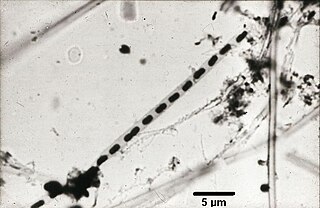
The Comamonadaceae are a family of the Betaproteobacteria. Like all Pseudomonadota, they are Gram-negative. They are aerobic and most of the species are motile via flagella. The cells are curved rod-shaped.
Oceanospirillaceae is a family of Pseudomonadota. Most genera in this family live in environments with high concentrations of salt; they are halotolerant or halophilic. They are marine, except Balneatrix which is found in fresh water and Venatorbacter, which is from terrestrial origin.All members are strictly aerobic, except Neptunomonas which can perform fermentation reactions.
The Lachnospiraceae are a family of obligately anaerobic, variably spore-forming bacteria in the order Eubacteriales that ferment diverse plant polysaccharides to short-chain fatty acids and alcohols (ethanol). These bacteria are among the most abundant taxa in the rumen and the human gut microbiota. Members of this family may protect against colon cancer in humans by producing butyric acid. Lachnospiraceae have been found to contribute to diabetes in genetically susceptible (ob/ob) germ-free mice.
Phenylobacterium is a Gram negative, strictly aerobic non-motile and bacterial genus from the family of Caulobacteraceae which can grow on chloridazon–mineral salts.
Hymenobacter is a Gram-negative and non-motile bacterial genus from the family Hymenobacteraceae.
Aquiflexum is a Gram-negative, aerobic, heterotrophic and non-motile bacterial genus from the family of Cyclobacteriaceae with one known species.
Belliella is a Gram-negative, aerobic, chemoheterotrophic and non-motile bacterial genus from the family of Cyclobacteriaceae.
Dysgonomonas is a Gram-negative and facultatively anaerobic genus from the family of Dysgonomonadaceae which have been isolated from human sources. Dysgonomonas bacteria can cause gastroenteritis in immunocompromised persons
Prauserella is a Gram-positive, aerobic and non-motile genus from the family of Pseudonocardiaceae.
Kofleriaceae is an aerobic family of bacteria from the order of Myxococcales.
Johnsonella is a Gram-negative, non-spore-forming and non-motil bacterial genus from the family of Lachnospiraceae with one known species. Johnsonella ignava occur in the gingival crevice of humans.
Sporobacterium is a Gram-positive, strictly anaerobic and chemoorganotrophic bacterial genus from the family of Lachnospiraceae with one known species. Sporobacterium olearium produces methanethiol.
Craurococcus is a Gram-negative and non-motile genus of bacteria from the family of Acetobacteraceae with one known species.
Marinococcus is a Gram-positive, strictly aerobic, chemolithoautotrophic and non-spore-forming genus of bacteria from the family of Bacillaceae.
Paraliobacillus is a Gram-positive, facultatively anaerobic and endospore-forming genus of bacteria from the family of Bacillaceae.
The Dermatophilaceae is a Gram-positive family of bacteria placed within the order of Actinomycetales. Dermatophilaceae bacteria occur on animal and human skin and in fish guts.
Hahella is a Gram-negative, facultatively anaerobic genus of bacteria from the family of Hahellaceae.
Singulisphaera is a moderately acidophilic and mesophilic genus of bacteria from the family of Planctomycetaceae.
Desulforhopalus is a Gram-negative, strictly anaerobic, and non-motile genus of bacteria from the family of Desulfobulbaceae.
Terrimonas is a Gram-negative, aerobic and non-motile genus of bacteria from the family of Chitinophagaceae.
